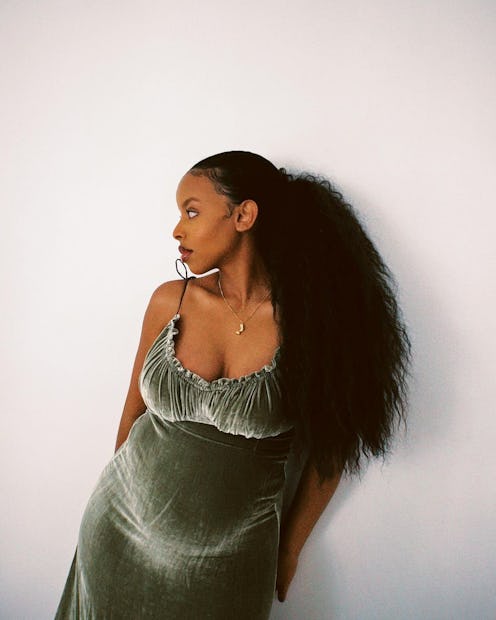(Hair)
This Ancient Plant Could Be The Key To Impossibly Long, Strong Hair
Exploring Northern Chad’s Chébé traditions.

High up in the Guéra Massif mountains of Northern Chad, a flowering plant, Chébé, grows wild. For thousands of years, women of the region’s Bassara Arab tribe have harvested the Chébé’s russet seeds to pulverize them into a fine powder — the secret to their long, strong hair, for which they’re internationally known. While Chébé powder has been a traditional mainstay in the region since the Neolithic area, social media and cross-societal sharing have brought the practice around the globe. But to truly appreciate Chébé powder’s beautifying effects on hair, it’s critical to understand its rich history — and cultural significance today.
“The origins of Chébé are at least 7,000 years old,” says Salwa Petersen, founder of her eponymous beauty line to TZR. In fact, prehistoric cave paintings in the mountains even depict men applying Chébé, she explains. The practice of mixing the ground seeds with nourishing additives like shea butter — both for grooming and as an act of community, familial love — is as intrinsic to the region as song or storytelling. It’s an inextricable piece of culture, and one that’s starting to rise in popularity across the world as artisans and small brands introduce Chébé-powered products.
The History Of Chébé
As Petersen points out, Chébé’s been in use for thousands of years, as a time-honored tradition centered around social bonding. Typically, mothers, sisters, and daughters spend time carefully applying the mixture to each other’s sectioned-out hair to protect it, the nutrient-rich Chébé allowing hair to reach eye-popping lengths. Petersen says her own family has been in Northern Chad for at least 1,000 years and the practice acts as something of a time capsule, preserved in songs and stories passed down from generation to generation.
“Chad is the cradle of humankind,” she muses, “and I always love to say Chad is also probably the cradle of hair care.” And Petersen, a dual Chadian-French citizen who now lives in Germany, really knows hair care. Before launching her own brand, she was the first Chadian citizen to attend Harvard Law School and subsequently spent years in brand development at L’Oréal.
“Up until four or five years ago, nobody had heard of Chébé outside Chad and now it’s a hot new thing,” she says. But that’s a good thing in Petersen’s book. “It makes me incredibly proud. I’m very proud to be Chadian, and it makes me proud to take something from Chad [global], especially since it’s helping women.” Petersen explains to TZR that she works with Chadian women who support themselves and their families, even putting their children through school, by ethically producing Chébé powder. Considering women are essentially the stewards of the practice, she says, they should be the ones to financially benefit from this boom in popularity.
How To Use Chébé For Hair Growth
In traditional practice, Chébé seeds are harvested from the mountainous trees and allowed to dry out, sifted, then roasted like coffee before the final blending that turns them into the fine, soft powder that’s mixed with water and assorted moisturizers like shea butter and applied to the hair. As it’s worked into the hair in layers, the sectioned-off strands are braided for added protection, locking that all-important hydration in for long, impossibly strong hair. Chadian women don’t wash the mixture out, but rather just layer on more, keeping their scalps clear of Chébé to avoid buildup or hair-damaging tension.
While the classical method of applying Chébé is a very labor-intensive one, often lasting an entire day thanks to extreme hair lengths and the effort required to thoroughly work in the powder, Petersen’s signature Chébé leave-in conditioner is streamlined for easy, regular use. “We had touched on seven versions of this formula,” she tells TZR. “And I was like, I want a one-step formula — you don't need to use 20 hair care products. And it worked. We had clinical trials and I only stopped when the clinical team saw overnight results — then I was like, now we’re good!” she laughs.
Petersen says just a little bit of the leave-in goes a long way, recommending applying it to damp, just-cleansed hair but says plenty will prefer it on dry hair. “It’s something you can adapt to your own routines,” she adds. Petersen considers Chébé a gift from God, and it’s one she committed to sharing with as many people as possible.
We at TZR only include products that have been independently selected by our editors. We may receive a portion of sales if you purchase a product through a link in this article.